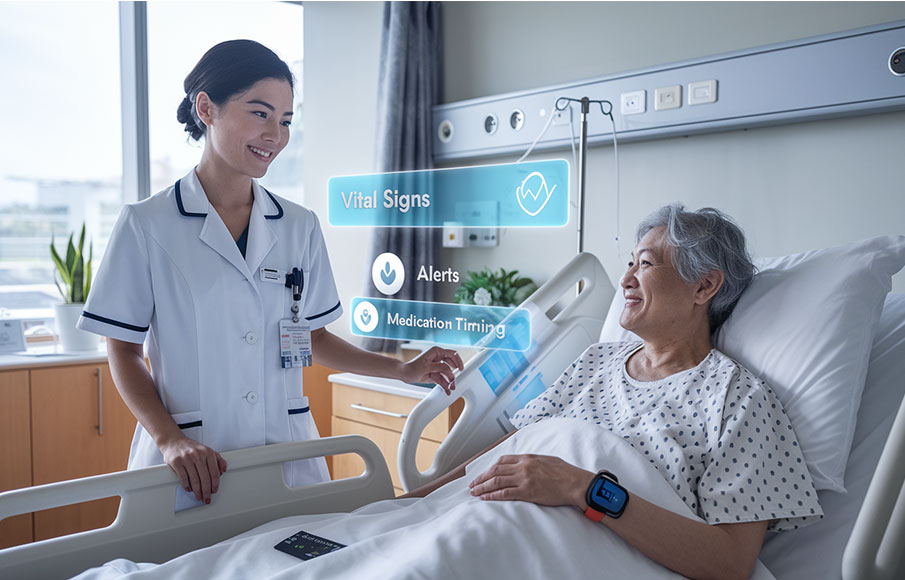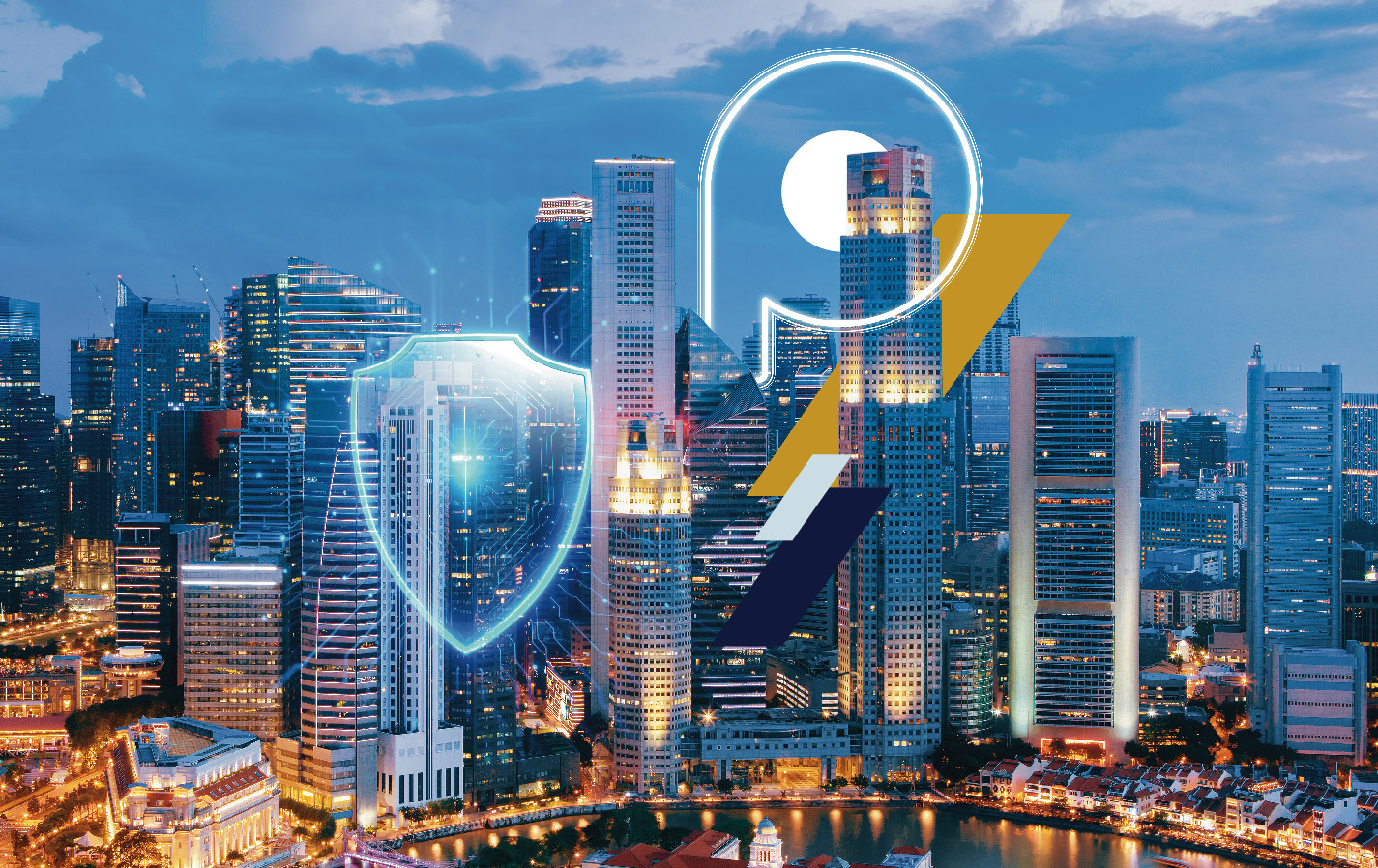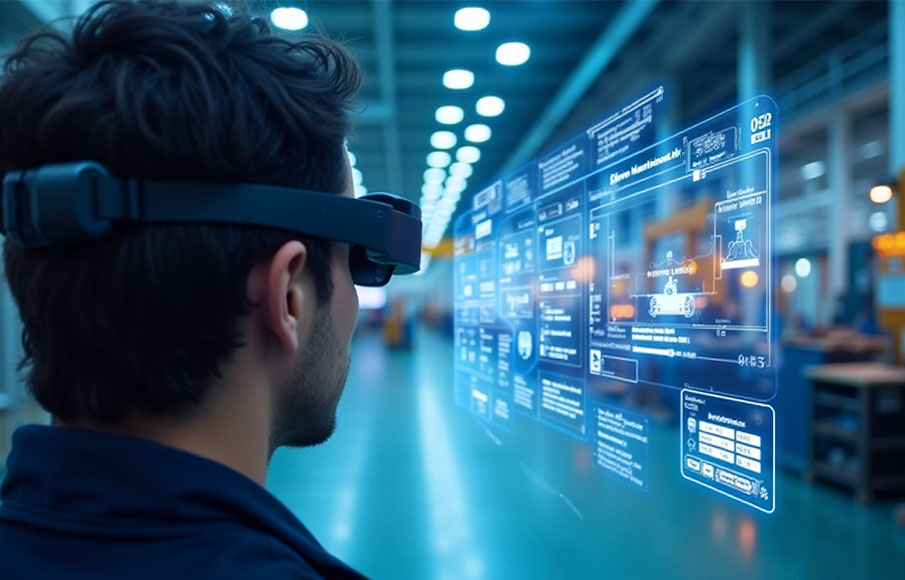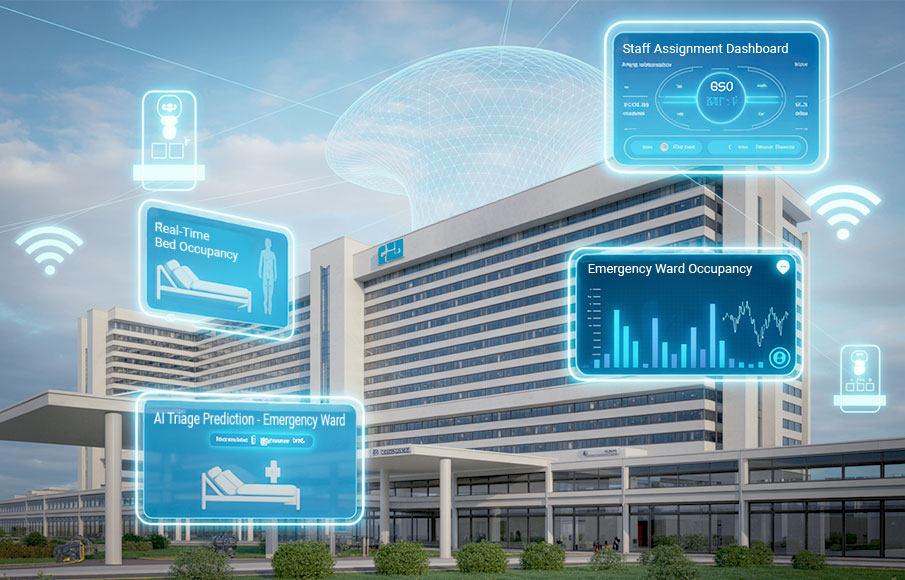Internet of Things in Singapore’s Healthcare: 5 Examples
- 26 May 2025

The Internet of Things (IoT) has transformed from a buzzword to an essential tool. Singapore is building a nation of smart hospitals and clinics, using connected devices to enhance patient care and operational efficiency.
Wearable IoT devices such as fitness trackers have also been issued to improve accessibility by remotely tracking and collecting patients’ health metrics, such as heart rate and sleep duration.
This article examines five examples of IoT implementation in Singapore’s healthcare sector and how SPTel’s solutions can support these innovations.
IoT and How It Works
Before exploring specific examples, let’s understand this technology and how it functions.
What is IoT?
IoT is simply a network of interconnected devices equipped with sensors and software. These smart devices can range from simple consumer objects to complex machines, including fitness trackers, home appliances, and vehicles. Devices fitted with IoT capabilities can communicate through wireless networks to share and collect data.
This allows people to live and work smarter through real-time insights. In essence, IoT technology empowers homes, industries, and cities with enhanced connectivity and intelligent automation, providing all manner of use.
How Does IoT Work?
At its core, IoT devices function by transforming raw information into actionable insights. The process involves essential components working together to create a seamless data flow.
IoT sensors collect and translate physical parameters into data, which is sent to a central cloud server for analysis. The processed data is then transmitted back to the source for action, such as notifying users or performing automated tasks. Insights can also be visualised through dashboard interfaces to observe patterns and real-time changes.
Here’s a quick breakdown of how IoT works:
| Steps | Function |
|---|---|
| 1. Sensing Devices | IoT sensors gather environmental information (e.g., temperature, motion, light, sound, and other conditions). |
| 2. Connectivity & Data Transmission | Collected information is transmitted as data by a processing node or a gateway. |
| 3. Cloud Storage | Processed data is sent to cloud servers (a central hub for device communication) to be analysed. |
| 4. Action & User Interaction | Based on insights from real-time data, commands are either sent back to source devices for action or presented to users via interfaces (dashboards, mobile apps). |
5 Examples of IoT in Singapore’s Healthcare

IoT in healthcare reduces tedious processes and risks of human error to improve service delivery and patient outcomes. From remote patient monitoring to inventory management, healthcare organisations across Singapore leverage connected devices for different medical purposes.
Here are five examples of successful IoT implementations that are reshaping Singapore’s healthcare industry:
| Telemedicine & Wearable Devices |
|
| Fall Detection |
|
| Asset Tracking & Management |
|
| Smart Hospitals & Clinics |
|
| Mixed Reality Surgery |
|
Key Benefits of IoT in Healthcare
IoT implementation in healthcare technology presents several key advantages. Successful implementation has positively transformed the way healthcare professionals and organisations work.
Here are 3 key advantages of IoT in Singapore’s healthcare environment:
1. Accuracy & Accessibility
- Enables proactive and accessible medical care for patients, allowing for more fruitful consultations and proactive care.
- IoT medical devices allow healthcare providers to remotely monitor patients and collect key health metrics more accurately.
2. Streamlining of Processes
- By automating tasks like clinic registration—for instance, by providing IoT-enabled self-service kiosks that allow patients to check in without human assistance—staff and resources can be more efficiently allocated.
- End-to-end connectivity provides the most up-to-date patient health data to doctors, allowing more informed decisions to be made.
- Enhancing patient safety using sensors that can detect falls and predict cardiac events or respiratory distress.
3. Research Efficiency
- Big data that would have taken years to collect manually is now more accessible due to information from IoT devices.
- Researchers can analyse this data for statistical studies and develop more effective medical treatments.
Challenges of IoT Deployment
While IoT delivers many benefits, deployment can be a hassle. Implementing a system of connected medical devices isn’t as simple. The vast amount of IoT devices, types, and providers creates significant connectivity-related hurdles, from managing multiple devices with different protocols to finding a one-stop solution to collect data.
Here are some common challenges of deploying IoT:
Lack of a Unified Platform for Managing IoT Devices
IoT integration typically involves different solutions from multiple vendors with individual platforms and management systems. This fragmentation creates troublesome data silos where vital information is segregated within separate systems. Solving this problem typically requires expensive and time-consuming platform integration projects.
For example, remote monitoring devices, smart medication dispensers, and environmental sensors collect valuable data independently. Without a unified platform, users cannot easily correlate the information for actionable insights.
Differing Connectivity Requirements
Healthcare systems often require an array of IoT devices with different connectivity protocols. Some medical devices use Wi-Fi for high-bandwidth applications, while others rely on LoRaWAN for long-range, or 4G/5G for mobile applications. This creates significant integration challenges, as organisations must ensure their platform can accept different connectivity protocols to receive data.
Multiple Vendor Management
IoT implementation usually presents the need to engage multiple vendors. From device manufacturers to network providers, platform developers, and cloud services, each component typically requires a separate supplier with its own contracts and support systems. Without a one-stop solution, deploying an efficient network of IoT devices can be troublesome.
Empowering IoT Deployment with SPTel’s Business-Grade Solutions

Successful IoT deployment requires organisations to overcome challenges of data silos, interoperability issues, and limited compute capabilities. Collected data requires a resilient and robust connection to transmit information back to headquarters or data centres. Edge cloud further improves latency and bandwidth for analytical processes like multi-reality operations.
Our centralised platform, combined with edge cloud capabilities and reliable backhaul connectivity, delivers a streamlined approach to IoT deployment in Singapore.
IoT-as-a-Service Platform
We’ve built a network of IoT partners whose solutions are already compatible with our platform, significantly simplifying your deployment process.
Here’s how it works:
- IoT-as-a-Service Platform: Unified platform for device management, data collection, and application enablement. This multi-protocol platform facilitates the collection and analysis of healthcare data, enabling real-time medical decision-making and improving the quality of care.
- Multi-Protocol Connectivity: Your IoT solutions can connect to our single platform regardless of protocol (WiFi, 4G/5G, NBIOT, or LoRaWAN).
- IoT Backhaul Connectivity: A one-stop shop that provides IoT sensor connectivity, backhaul connectivity (from the platform to your cloud/DC/HQ). SPTel’s diverse and resilient network creates reliable backhaul connectivity, even during disruptions.
Edge Cloud Computing for IoT
Our unique advantage lies in the network of secure Critical Information Infrastructure (CII) edge nodes across Singapore for edge cloud deployment. No other telecommunications provider offers this level of extensive edge cloud coverage, providing unmatched performance and reach.
Here’s how it works:
- Edge Cloud: Processing data closer to the source for more responsive application performance, especially for latency-sensitive solutions.
- Unified Cloud Management Portal: Allows users to manage resources from multiple clouds from a single dashboard.
- Island-wide Edge Nodes: A diverse network and 4 edge zones distributed across Singapore’s key commercial & industrial districts for performing pervasive multi-edge computing.
Get Started Today: Implement IoT Solutions with SPTel

IoT isn’t just present in Singapore’s healthcare—it’s empowering it in real time. These solutions transform healthcare delivery using instantaneous data-driven insights and automation. However, successful IoT implementation depends on a robust, unified platform to manage devices and facilitate data transmission.
We provide the elements to support your IoT initiatives:
- Subscription-based Model: Lower barrier of entry, with predictable costs on a subscription basis.
- Fast Implementation: IoT-a-a-S Platform is ready-to-use, minimising setup time for quick deployment.
- Scalability: On-demand scalability facilitates expansion to new locations or adding more IoT-enabled devices and sensors. Connect new sensors as needed on the platform.
- Multiprotocol IoT Platform: Enables IoT devices and sensors to connect to the platform regardless of application protocol.
- Responsive performance: Improved application responsiveness for real-time data processing with secure, Edge Cloud locations closer to the data source.
With SPTel, you can build a secure and scalable IoT infrastructure that meets evolving needs. Learn more about our IoT-as-a-Service Platform and Edge Cloud solutions.
Contact our experts today to begin your IoT journey!












